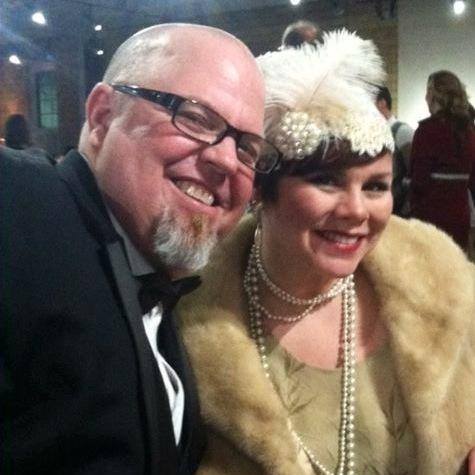Donors

Brent and Vic Stevens at the 20’s party
Brent Stevens
Growing up in Van Wert was, for me, the perfect childhood. I lived in the country with my mom, my dad, and my brother. We would fish, hike, and ride bikes without a care in the world. One day I was out working in the garden with my grandfather. I stumbled and fell and right in front of me was an arrow head. I started thinking about the people that were here before us, the people that made this arrowhead. My grandfather then told me about a local artist who he knew that painted Indians. I would later find out it was David Humphreys Miller. Later, Grandpa bought a painting of Lew Miller’s, David Humphreys Miller’s father, at an auction in 1977. This painting was Onebull, who was Sitting Bull’s adopted son and the first to engage in battle at the Little Bighorn with Custer’s troops. Lew painted this when visiting David in 1938 on a trip to South Dakota.
I fell in love with Mr. Miller’s story; going to find survivors of the battle of Little Bighorn at the age of 15, by himself. He drove to South Dakota, alone, with $100 in his pocket, in the family’s car. Today’s kids can’t play in the front yard by themselves. I decided I would collect his paintings after years of collecting arrowheads in the field. Vicki, my wife, bought my first painting, which is Bird Horse, at the Paul Good Estate Auction in Van Wert. From then on it was an obsession.
While I tease my high school history teacher that I don’t remember having him as a teacher, he was very influential in my love of history. Joe Stephen was one of the reasons I took archeology in college. And now I suppose I can no longer pretend not to remember taking his class.
I want the Wassenberg to put my collection on permanent display. My father was a teacher here in Van Wert. Eduction, regardless of what the student was interested in, was important to him. If they liked art, he would encourage them to follow that path. Sports, music, math, history; it didn’t matter. He encouraged the kids to do what they loved. I hope David Humphreys Miller’s story does the same. Miller followed what he loved and it took him all over the world. He became a great artist, he became a great historian, and he built a life around what he loved, painting Indians. He spoke to over 72 warriors and got their side of the story of the battle of Greasy Grass, what the Indians called the battle at Little BigHorn. He became close friends with them and created opportunities in the movies in Hollywood, but most importantly to me, he documented their side of the story.
I hope this collection has a way to inspire of the kids in Van Wert to work hard and follow their dreams and be able to create a life doing what they love. Van Wert can be an awesome place to start their lives and follow their dreams all over the world!
We have created the web site DavidHumphreysMiller.org. With this website it will be an opportunity to tell Miller’s story. We want to document and register as many works of art of his as possible. We also plan on having the county history classes help research and write information about each one of the Indians he painted. The information will be credited on the website to the high school student that is responsible for the research. I also hope that we can get the art classes to come in and study Miller’s techniques, drawing and painting the same subjects in their own way.
My desire is to create a museum within the Wassenberg Art Center that will bring people from all over the country to see the “Faces of the Little Bighorn,” to understand that one of Van Wert’s own documented such a historic event, that he wrote books, and went on to act and advise on over 35 movies. He was a writer for the Daniel Boone series. He was a Veteran of World War 2 and served in China with the Flying Tigers.
I am excited to have this collection on permanent display in Van Wert. I just want to say thank you to my hometown and to my family. I want to say thank you to those who encouraged me, and to offer what “can be” to those kids that wonder what it would be like to follow what makes you happy, as Miller did. And finally, thank you to Hope Wallace. This association with the Wassenberg would not have been possible if it wasn’t for her. I am really looking forward to working with her in the years to come.
